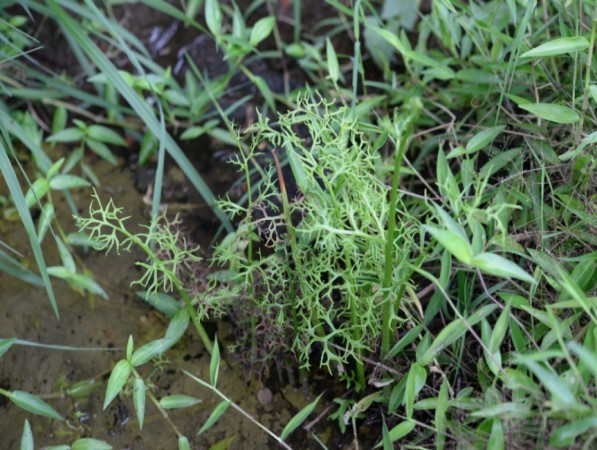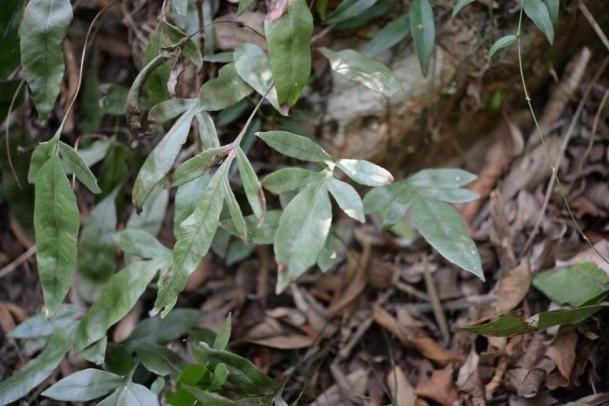Two new species of ferns were discovered in Dapeng New District, Shenzhen, Guangdong
Recently, scientists from the South China Botanical Garden of the Chinese Academy of Sciences, together with other institutions, have identified a new species of Ceratopteris, named "Ceratopteris baguangensis" after its discovery site in Dapeng New District, Shenzhen. Additionally, a new species of Leptochilus belonging to the family Polypodiaceae has been discovered. These findings have been published in Phytotaxa, an international journal dedicated to plant taxonomy. This research was funded by the Science and Technology Planning Project of Guangdong Province, China, Guangdong Flagship Project of Basic and Applied Basic Research, and other projects.
During the coastal zone biodiversity survey in Dapeng New District in 2023, researchers from the South China Botanical Garden of the Chinese Academy of Sciences and Guangdong Academy of Forestry discovered a unique species of the genus Ceratopteris in Baguang. This species exhibits leaf morphology that significantly differs from its relatives. After further sample comparison, phylogenetic analysis and chromosome number observation, the research team finally confirmed it as a new species of Ceratopteris. It is found that compared with C. thalictroides, C. baguangensis is more closely related to C. oblongiloba, which form sister group. Based on the collection site of the new type specimen, it was named Ceratopteris baguangensis. It grows in the estuary wetland at the junction of saltwater and freshwater in the coastal zone of Baguang Heritiera littoralia Wetland Park, with a pH value of 6.8 and a salinity of 0.14‰.
Ceratopteris baguangensis is 26.5-35 cm tall, with short and upright rhizomes that cluster in mud; Sterile and fertile fronds are 22-35 cm and 25-40 cm long, respectively, inverted triangular or narrow circular; blades are 12-30 cm in length, apex acuminate, base rounded–cuneate, 2–3 pinnate; pinnae 3–8 pairs, oblique, stipitate, obtriangular, nearly palmately divided; lobes 2–5 pairs, alternate, oblique, apex acuminate, narrowly linear, revolute up to the main vein; tipes are 8–20 cm long, terete, fleshy, smooth.
All species of the genus Ceratopteris, including C. baguangensis, are listed as second-class national key protected plants in the "National Key Protected Wild Plants List" of 2021 and classified as vulnerable (VU) in the "IUCN Red List of Endangered Species". Ceratopteris thalictroides, a close relative, is popularly known as dragon beard vegetable, dragon tooth grass, or water celery, valued both medicinally and as a vegetable or ornamental plant in horticulture. Given the limited wild population of C. baguangensis, it is crucial to enhance protection efforts for this species and its habitat and consider its propagation for sustainable use.
The discovery of Ceratopteris baguangensis not only enriches the biodiversity resources in coastal wet areas but also provides new materials for the systematics and evolutionary study of Ceratopteris. With six recognized species of Ceratopteris in China till now, researchers are committed to further investigations to deepen this understanding of plant evolution and inform conservation and utilization strategies.
At the same time, researchers from the South China Botanical Garden, Chinese Academy of Sciences and Shanghai Chenshan Botanical Garden also found the natural distribution of a new species of Leptochilus tridigitatus in Dapeng New District. This species is similar to L. tridigitatus, but the leaves of L. tridigitatus are dimorphic, with fewer lobes in sterile fronds, and the leaves are single or triple lobed, which is quite strange in shape. This species was published in Phytotaxa in 2024.
The article link is: https://doi.org/10.11646/phytotaxa.658.2.8
https://doi.org/10.11646/phytotaxa.650.2.2

Figure 1. Ceratopteris baguangensis.(Image by WANG et al)

Figure 1. Leptochilus tridigitatus.(Image by WANG et al)
File Download: